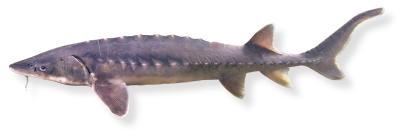Atlantic Sturgeon
Acipenser oxyrinchus
 Distribution: Atlantic sturgeon spawn in Atlantic coastal rivers from Newfoundland to Louisiana. While at sea, Atlantic sturgeon aggregate on foraging grounds along the coastal plain including areas in the Bay of Fundy, Long Island Sound, and off the coast of Virginia. They are a wide ranging fish species and may occasionally forage in the Great Bay Estuary. There is at least one record of Atlantic sturgeon accidentally caught in the estuarine portion of the Salmon Falls River. Since 2012, three Atlantic sturgeon have been picked up by acoustic telemetry receivers in the Piscataqua River and near the mouth of the Oyster River. These fish were tagged in the Saco River, Merrimack River, and near Long Island Sound in unrelated studies.
Distribution: Atlantic sturgeon spawn in Atlantic coastal rivers from Newfoundland to Louisiana. While at sea, Atlantic sturgeon aggregate on foraging grounds along the coastal plain including areas in the Bay of Fundy, Long Island Sound, and off the coast of Virginia. They are a wide ranging fish species and may occasionally forage in the Great Bay Estuary. There is at least one record of Atlantic sturgeon accidentally caught in the estuarine portion of the Salmon Falls River. Since 2012, three Atlantic sturgeon have been picked up by acoustic telemetry receivers in the Piscataqua River and near the mouth of the Oyster River. These fish were tagged in the Saco River, Merrimack River, and near Long Island Sound in unrelated studies.
It is not known how far Atlantic sturgeon upstream Atlantic sturgeon once swam up the Merrimack River before the construction of dams in the 1800’s, but historical records from the 1600’s indicate that sturgeon were caught in the river up to Amoskeag Falls in Manchester (although no distinction was made between shortnose and Atlantic sturgeon).
Description:Atlantic sturgeon have a prehistoric appearance, with a long pointy snout and rows of hooked plates along its body instead of scales. They are a heavy bodied fish with a shape that resembles a pentagon when observed from the front. The large dorsal fin is positioned on the rear third of the body, just above the anal fin. The upper lobe of the caudal fin extends past the lower lobe.
Species Commonly Confused With: Shortnose sturgeon
Habitat: Atlantic sturgeon are highly migratory, moving between freshwater rivers, estuaries, and ocean habitats. Spawning takes place in freshwater over gravel or rocky substrate. Juveniles drift down to areas of soft sediment usually at the upstream edge of tidal influence. At sea, Atlantic sturgeon are found at relatively shallow depths, usually between 5 and 150 meters.
Life History: Atlantic sturgeon are anadromous, meaning that they spawn in freshwater, but spend most of their lives in the ocean. Spawning migrations occur during the spring in large freshwater rivers. Females produce an enormous number of eggs (from 1 to 4 million depending on their size), although mature individuals do not spawn every year. The eggs hatch quickly, in about a week. Atlantic sturgeon fry remain in the interstitial spaces of the course substrate where they hatch. They are sustained initially by a yolk sac, but they are equipped with teeth to feed on small organisms attached to rocks. After they reach about 15 mm in length, the juvenile Atlantic sturgeon drift downstream to estuarine habitats. They may remain in their natal river many years before moving out to sea.
Atlantic sturgeon are slow to reach sexual maturity. Spawning activity does not begin until about 10 years of age among northern populations. They are a long lived species, reaching over 60 years of age and up to 14 feet in length. Atlantic sturgeon feed on invertebrates and small fish, for which they forage by rooting along the bottom with their pointed snouts and sucking in both prey and bottom sediments with their downward pointed mouths. Despite their habit as bottom dwellers, Atlantic sturgeon are sometimes observed jumping from the water in a behavior known as “breaching”. The reason for breaching is unknown, but researchers have speculated that it may help remove parasites.
Origin: Native
Conservation/Management: Atlantic sturgeon were once abundant in the estuaries and larger rivers of the northeast. Early maps sometimes referred to the Merrimack River as the “Sturgeon River”. They were one of the first fish to suffer from over harvest during the early colonial period beginning in the 1600’s. They were harvested as a food source, but their most notable commercial product was their eggs, which were shipped to Europe as caviar to replace the dwindling supply of caviar from the over harvested sturgeon populations in the Black Sea.
Atlantic sturgeon have been grouped into 5 distinct population segments (DPS); (1) Gulf of Maine (GOM), (2) New York Bight, (3) Chesapeake Bay, (4) Carolina and (5) South Atlantic under the federal Threatened and Endangered Species Act. The Gulf of Maine DPS is listed as Threatened, while the other four populations are listed as Endangered.
Atlantic sturgeon are managed by the Atlantic States Marine Fisheries Commission (ASMFC). A moratorium on commercial fishing was issued in 1998 and will continue until 20 adult year classes have been established. It is estimated that this could take until at least 2038. Anecdotal evidence suggests that there has been some improvement in the Gulf of Maine Atlantic sturgeon population since the moratorium, but the population was still considered depleted in the ASMFC Atlantic Sturgeon 2017 Benchmark Stock Assessment. The National Marine Fisheries Service has prohibited landing Atlantic sturgeon as bycatch in other federally regulated fisheries. There is a need for more research on the movement patterns and habitat needs of Atlantic sturgeon throughout their life cycle.



